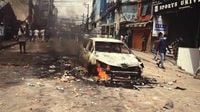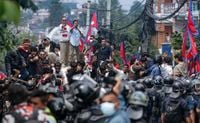From Kathmandu to Antananarivo, from Novi Sad to Lima, a wave of youth-led protests—driven by Generation Z—has swept across continents, demanding an end to corruption, inequality, and the abuse of power. In a world increasingly shaped by digital connections and social media, these movements have become impossible to ignore, often erupting with a speed and ferocity that leaves governments scrambling and, in some cases, toppling altogether.
Nowhere has this phenomenon been more dramatic than in Nepal. On September 8, 2025, the government’s decision to block 26 social media platforms, including Facebook and TikTok, was meant to stifle dissent. Instead, it ignited a firestorm. According to Nepali Times and Global Voices, tens of thousands of young Nepalis took to the streets under the banner of the “Nepo Kids” movement, a viral trend exposing the privileges of politicians’ children while ordinary youth struggled with unemployment and broken promises. The government’s attempt at information control backfired spectacularly.
Protests in Kathmandu quickly escalated into violence. By the evening of September 8, at least 19 people had been killed, as reported by Nepali Times. Curfews blanketed the city, and scenes of chaos unfurled just outside media offices. “I cried a lot,” recalled Sunita Karki, a journalist at Annapurna Post, describing the guilt and helplessness she felt watching wounded teenagers being rushed to hospitals and police beating protesters. That same night, her newsroom was set on fire. “If we have to hide our identification cards in every protest, what kind of journalist am I?” she questioned, torn between her duty and her own safety.
Other journalists faced similar dangers. Angad Dhakal of Kantipur National Daily rushed to his office to save hard drives containing a decade’s work, only to watch the building burn. “My office was burning. What should I photograph?” he asked, forced to remove his press jacket to avoid being targeted. Gaurav Pokharel at OnlineKhabar described lowering blinds and locking doors as threats swirled online. Even the Singha Darbar complex, home to Nepal Television and Radio Nepal, was set ablaze, and staff scrambled to keep broadcasts on air amid the chaos.
The violence was not limited to Kathmandu. According to Deutsche Welle, the protests spread across Nepal, with the death toll rising to at least 72 as state institutions went up in flames. The government of Prime Minister Khadga Prasad Sharma Oli collapsed within a day, marking a seismic shift in the country’s political landscape. In the aftermath, former Chief Justice Sushila Karki—known for her anti-corruption stance—was appointed Prime Minister following an online vote, a move hailed by protest leaders as a sign of “continued political awakening shaped by Generation Z.”
This youth-led revolution was not the product of foreign meddling, despite speculation about the roles of India and China, but rather a homegrown response to years of corruption, patronage, and unfulfilled democratic promises. As Nepali Times and Global Voices reported, Nepal had cycled through 14 governments since becoming a republic in 2008, each plagued by infighting and a lack of transparency. The “Nepo Kids” trend, which highlighted the stark divide between political elites and ordinary citizens, proved to be the spark that set off the powder keg.
Social media played a critical role in both organizing the protests and documenting the government’s violent response. Officials had hoped that cutting access would suppress dissent, but instead, the ban galvanized protesters, and when it was lifted under pressure, graphic evidence of shootings spread at viral speed. The result was a nationwide revolt, with millions coordinating via digital platforms and political parties seizing the moment to amplify the movement.
The events in Nepal mirrored similar uprisings around the globe. In Madagascar, protests led by well-educated young people between 18 and 28 years old called for the resignation of President Andry Rajoelina and an end to mismanagement and corruption. The demonstrations, sparked by power outages and water shortages, resulted in at least 22 deaths and 100 injuries, according to UN data reported by Deutsche Welle. “It is our duty to really change everything. It is certain that we expect the change of government and the resignation (of the president). First of all, the resignation,” said Heriza Andriamanantena, spokesperson for Generation Z Madagascar.
In Serbia, Generation Z protests erupted after the roof collapse at Novi Sad’s main train station killed 16 people, a tragedy blamed on corruption and construction failures. For nearly a year, students and young activists occupied university campuses, blocked intersections, and clashed with the offices of President Aleksandar Vučić’s party. Despite attempts at suppression, the protests persisted, driven by demands for transparency and democracy.
Elsewhere, youth movements have taken on local flavors but share common grievances. In Morocco, protests against corruption and the government’s decision to prioritize stadium construction for the 2030 World Cup over hospitals led to 280 injuries and more than 400 arrests. In Paraguay and Peru, young people rallied against nepotism and unpopular reforms, with slogans like “We are the 99.9 percent and we don’t want corruption” echoing through the streets of Asuncion and Lima. The pirate flag from the manga One Piece—a symbol of freedom and justice—became a common sight at these demonstrations.
The Nepal crisis now poses a daunting challenge: can the country’s political classes restore trust and deliver credible elections before disillusionment hardens into further instability? With elections scheduled for March, the stakes are high. As Nepali Times observed, reinstating discredited leaders would only deepen cynicism, while drafting a new constitution would be costly and unnecessary. The core demands of the Gen Z protesters—accountable leaders, an end to nepotism, and a political system that lives up to democratic ideals—remain unresolved.
Equally urgent is the need to balance free expression with the risks of disinformation. The recent ban on social media showed that heavy-handed censorship can ignite revolt, yet unchecked misinformation also threatens democracy. The answer, analysts argue, lies in building resilient institutions, investing in digital literacy, and holding online platforms accountable for the content they host. As Subina Shrestha wrote in Nieman Reports, Nepal’s legacy media “reacted” to the uprising rather than shaping its narrative, losing the trust of a generation attuned to memes and Discord. Strengthening independent journalism and civil society is now seen as critical to safeguarding the country’s fragile democracy.
What happened in Kathmandu is resonating far beyond Nepal’s borders. Generation Z’s global protests, powered by digital tools and a deep-seated demand for justice, are redefining the terms of political engagement. Whether these movements can deliver lasting change remains to be seen, but their message is clear: the anger of a connected generation cannot be ignored.
As Nepal prepares for a pivotal election, the world is watching to see if democracy can rise from the ashes of revolt and whether youth-led activism will reshape politics for a new era.


